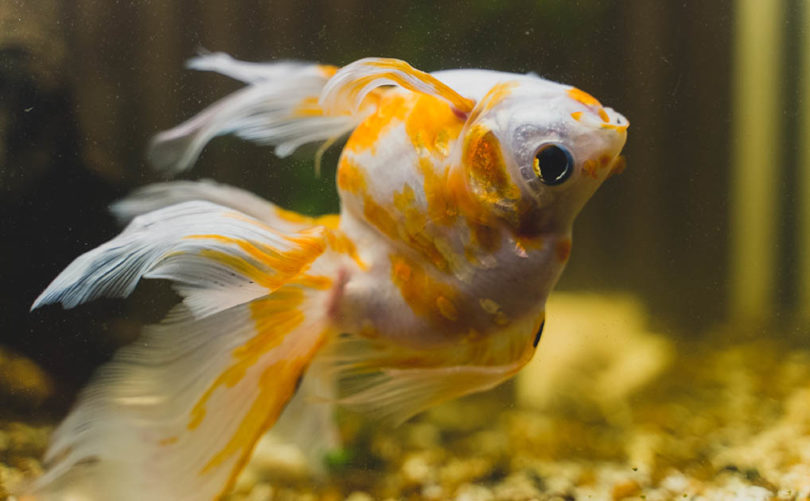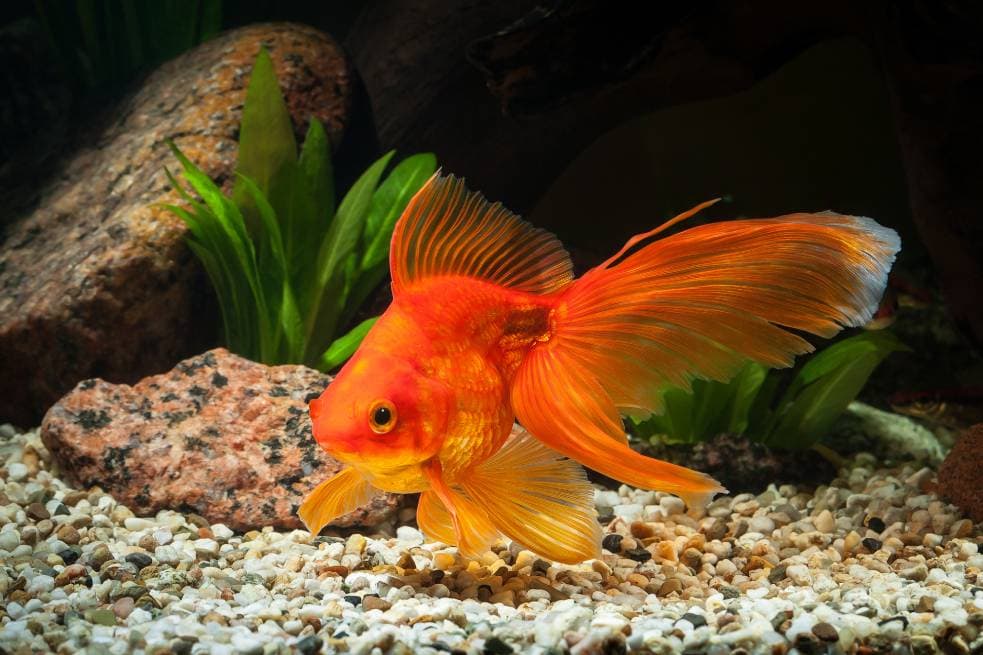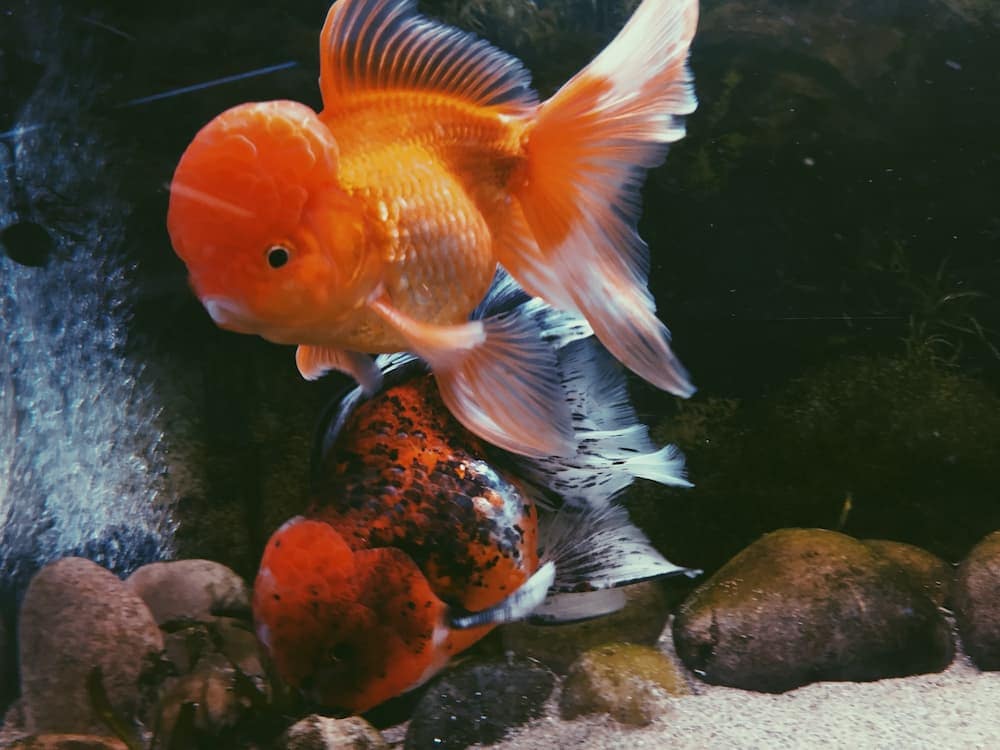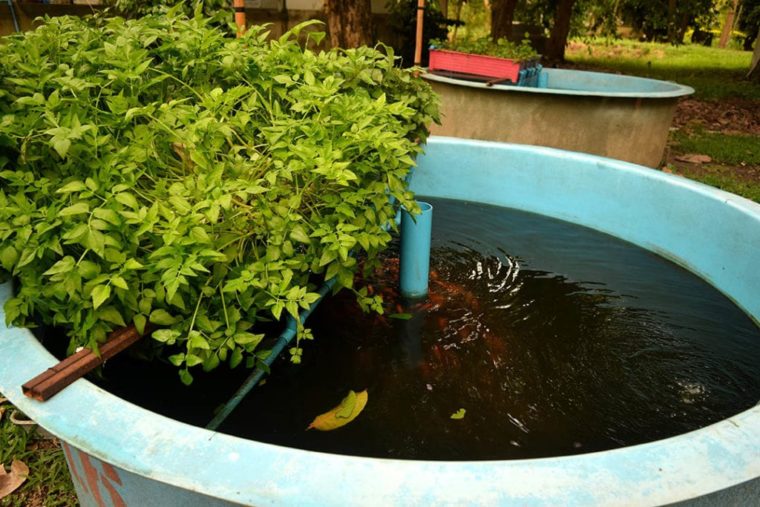
The goldfish hobby is continuously growing. New trends and ideas are popping up, and goldfish aquaponics is becoming increasingly popular in the hobby. Investing in goldfish may take a lot of time and money, but it is worth it. There is nothing better than creating a beautiful and unique living environment for your goldfish that you both can enjoy.
Getting into goldfish aquaponics is a great idea for goldfish lovers who want to improve their goldfish care and, ultimately, their goldfishes housing setup while growing and maintaining healthy plants for cultivation.
Goldfish Aquaponics 101 – Explained
You may be unfamiliar with the term ‘goldfish aquaponics.’ Goldfish aquaponics are the creation of a symbiotic environment between goldfish and the plants they fertilize. It works as a production system that combines aquaculture and hydroponics together.
In simpler terms, aquaponics is where you keep fish in a large tub or pond, with cultivating plants that use the water the fish are in to grow and absorb nutrients.
The goldfish waste is rich in nitrogen, beneficial for plant growth and vitality. The fish produce this waste inside the water and the plants will then absorb the nutrients from the waste. This system benefits both the goldfish and plants because the plants are naturally cleaning the water and gaining nutrients from the goldfish waste.
You can use goldfish aquaponics for both large and small-scale farming purposes. Goldfish aquaponics is a good idea if you want to keep an aquaponic system in your home to grow herbs and other plants that you can use for food. However, suppose you want to grow and cultivate herbs and other plants in large quantities. In that case, you can choose to set up a large tub with lots of goldfish to produce a hefty number of plants, or you can use multiple goldfish aquaponic systems to have the same result.
A Scientific Explanation
Following the standard definition of how goldfish aquaponics works, you may still be wondering the science behind this setup.
First, goldfish eat the food you provide for them, which then gets digested and passed in their waste in the form of ammonia. Then, this ammonia gets converted into nitrites through the beneficial bacteria, which is required for the plants to grow. Finally, once the plants absorb the nitrates, they clean the water for the fish.
Are Goldfish Good for Aquaponics? Which Varieties Are Right for You?

Goldfish are ideal for aquaponic systems because they are hardy, beautiful, and adaptable fish. Starting an aquaponic system for goldfish is simple and inexpensive once you understand the setup required and how to care for them.
Furthermore, goldfish are easy to care for, and with so many different varieties of goldfish available, you have an endless choice of goldfish that you can add to your aquaponic system.
Why even consider using goldfish for aquaponics? Goldfish are very hardy fish that can tolerate a wide range of conditions that other fish species would cease to thrive or survive in. They are adaptable and inexpensive to keep. This means that they will quickly adapt to living in an aquaponic system both indoors and outdoors without using a heater and other expensive aquatic equipment. They also produce a large bioload of ammonia that gets converted into nitrates, which are readily absorbed by all plant species.
Some ideal varieties of goldfish for aquaponic systems are:
Single-Tailed Goldfish
Fancy Goldfish
In terms of what goldfish variety does best in an aquaponic system, single-bodied or ‘streamlined’ goldfish are the better option. This is because single-bodied goldfish are hardier than fancy goldfish because they have kept their natural body shape even through decades of selective breeding. They will swim better and find their food easier than to fancy goldfish.
As for fancy goldfish, they have difficulty getting around because their stocky bodies are not proportionate to their fins. When kept in an outdoor aquaponic system, you may find that fancy goldfish, such as ryukins and orandas, will be slow-moving, and have difficulty getting to their food, making them more susceptible to predators. They may be better suited to indoor or patio aquaponic systems, but some varieties, such as fantails, have thrived in outdoor aquaponics.
Furthermore, single-bodied goldfish look more attractive when viewed from the top, whereas fancy goldfish are better for tanks where you can get a full view of them to fully appreciate their beauty.
How Many Goldfish Do You Need for Aquaponics? (Stocking Guidelines)

The amount of water and plants growing in the aquaponic system will determine how many goldfish you will need. If you have a body of water with fewer than 50 gallons, you can keep around two to four goldfish inside. Larger bodies of water over 100 gallons in size can hold more goldfish.
Since goldfish produce a lot of waste, you will need to cultivate many plants into the aquaponic system to make sure the waste products are being dissolved effectively. Also, if you have fewer goldfish, you may struggle to balance the waste produced and the speed at which the plants absorb the nitrogen and other nutrients from the water.
A general guideline to follow when stocking an aquaponic system with goldfish is to consider how much space the goldfish require to swim freely without feeling cramped. Even if your primary reason for starting a goldfish aquaponic system is to grow healthy plants, you still need to consider the needs of the goldfish as an aquaponic system can only thrive if the conditions are right for the fish as well.
If you are looking for help to get the water quality just right for your goldfish family in their aquarium, or just want to learn more about goldfish water quality (and more!), we recommend you check out the best-selling book, The Truth About Goldfish, on Amazon today.
It covers everything from water conditioners to tank maintenance, and it also gives you full, hard copy access to their essential fishkeeping medicine cabinet!
Now let’s say you have a small tub with fewer than 80 gallons of water. You will need to carefully choose the right variety and size of goldfish to live in this tub. You need to consider the variety’s growth rate and adult size. If you keep a group of large single-bodied goldfish like comets in the tub, then they may soon outgrow it and the bioload will pile up to the point that the goldfish will be swimming in their own waste because no number of plants will be able to absorb their waste fast enough. If the bioload builds up to a fatal level, the goldfish may start to die off, which will have an adverse effect.
Stocking Guideline:
How to Start a Goldfish Aquaponic System (Design & Set up)
You will need four basic essential items and equipment to get started. This includes the tub, the plant media, the choice of goldfish, and an effective plumbing system so that the water can flow to the plants,
Step 1: Purchase a large tub with the desired size you want the body of water to be. Keep the stocking guideline in mind, so you do not introduce the goldfish into a cramped environment. You also have the option of purchasing a custom-made tub if you cannot find a large enough tub from a store that is the right size.
Step 2: Place the chosen media into the top tub where the plants are kept. The growing media can be clay pebbles, rock wool, pine shavings, and water-absorbing crystals. This is where the plants will be growing, so you must ensure that it is not soil or dirt as this can hold too much moisture for an aquaponic system.
Step 3: Choose the plants/crops you want to grow and bury them from the roots into the growth media.
Step 4: Connect the piping system to the tub to ensure good water flow.
Step 5: Fill the large tub with dechlorinated water and finally add the goldfish of your choice.
Ensure that the aquaponic system has been placed in a desirable spot where the plants can receive adequate sunlight without worrying about the goldfish’s water becoming too warm. If you are using an aquaponic system indoors or on a patio, then you may need a plant growth light directly over the plants but not over the goldfish.
Caring for Goldfish in Aquaponic Systems
Water Changes
Water changes will only be necessary during the first few weeks after you have set up the aquaponic system. All you will need is a bucket and a cheap siphon you can purchase at a pet store. Every few days, you much siphon the bottom of the tub to suck up the poop left behind from the goldfish and you only must change a small amount of water at a time, around a bucket full. Once the tub is fully cycled, you will not have to do this anymore, as the aquaponic system should be fully functioning by this point.
Feeding
The goldfish should be fed high-quality food every day. This is the most you will have to do to care for your goldfish in an aquaponic system. Pelleted foods are ideal and recommended over flakes which dissolve quickly in the water. You can also supplement their diet with deshelled peas to help the goldfish pass waste more efficiently.
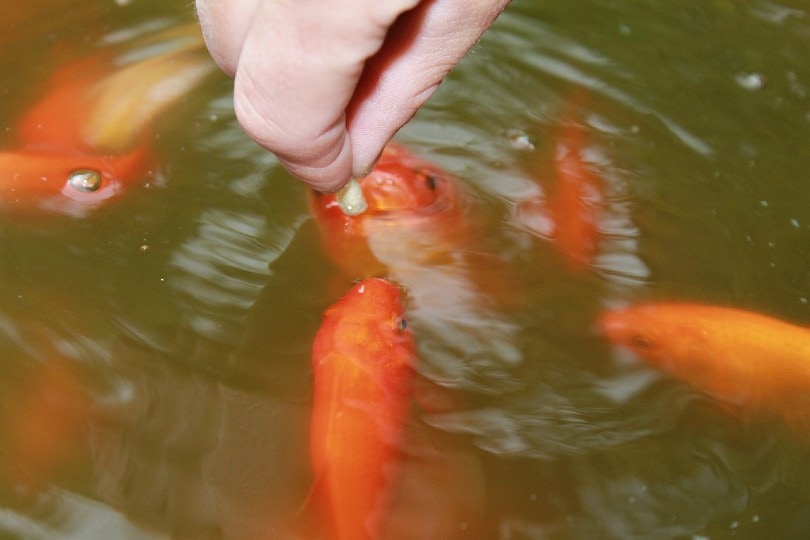
Health Checks
Daily health checks should be conducted on the goldfish to ensure that they have not fallen ill or died, which can pollute the water quality. Check that none of the goldfish have any physical injuries or diseases and that they are not acting lethargic and laying on the bottom of the tub. This can indicate that they are seeking and will require a week-long quarantine period and medication until they are better. Never put medication into the tub directly as it can harm the plants.
Benefits Of Goldfish Aquaponics
Conclusion
After a few days of your goldfish aquaponic system running, you will notice that the plants may look livelier and have a faster growth rate. It may take time, but the benefits of goldfish aquaponic systems are seen relatively quickly.
We hope that this article has helped you understand the basics behind goldfish aquaponics and how you can successfully raise both plants and your goldfish in a sustainable manner.
You Might Also Be Interested In:
- 7 Best Aquaponic Aquariums
- How Long Do Goldfish Live? (Average Lifespan Data & Facts)
- 4 Best Organic Aquaponic Fish Foods
Featured Image Credit: tanakornsar, Shutterstock




